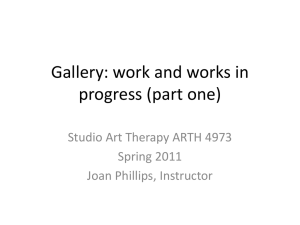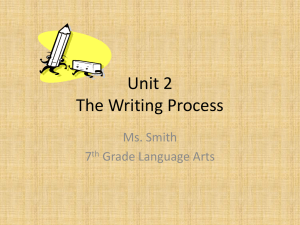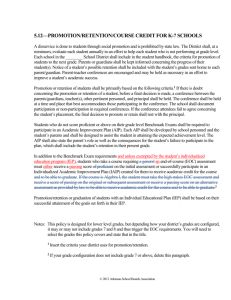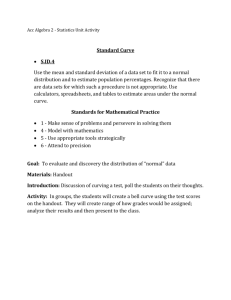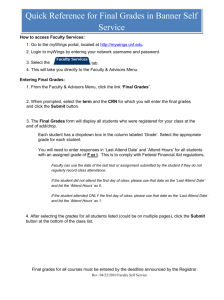To Determine if Technology Can Help To Improve
advertisement
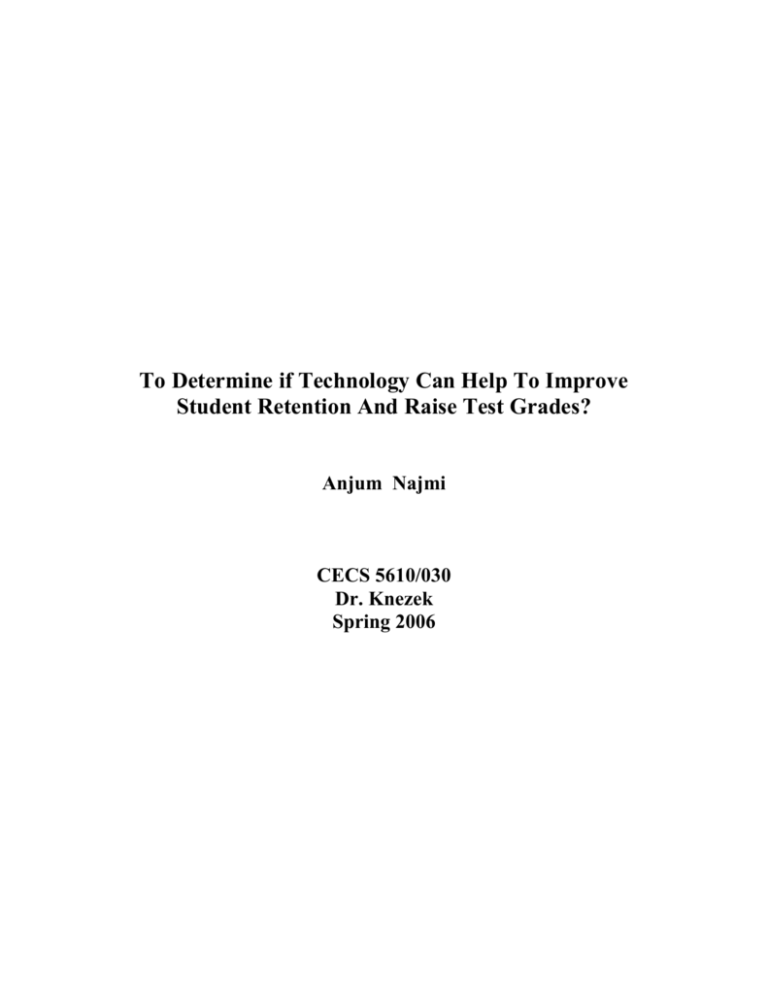
To Determine if Technology Can Help To Improve Student Retention And Raise Test Grades? Anjum Najmi CECS 5610/030 Dr. Knezek Spring 2006 Objective To evaluate if technology (Inspiration software) can improve student retention and raise test grades for at risk students at the middle school level. Perspective & Theoretical Framework Numerous research and findings, on everyday experiences of educators, students, and their families indicate that technology can enhance achievement for all students. The process of learning is made significantly richer for them as student’s access new and different types of information. Positive effects have been found in all major subject areas from preschool through higher education, and for both regular education and special needs students. Technology is seen to improve student attitudes towards learning and increase self-concept. Computer-based instruction motivates, it gives students greater self-esteem and more self-confidence. This is particularly true when learners are allowed to control their own learning. Students work at their own pace, take more initiative and learn independently. Thus, technology in the learning environment makes learning student-centered, more cooperative and increases teacher/student interaction. However, specific student population, software design, teacher’s role, and student access to technology can influence the level of learning achieved (Chang, Kuo-En & Lin, Shiu-Feng). Other factors that impact the use of technology are student motivation and attitude towards learning. Literature on classroom learning shows that motivation plays an important role in student learning and achievement. When motivated, students approach challenging tasks eagerly, they continue to persist when faced with difficulty, and take pleasure in the tasks they achieve. Research shows that instructional context, strongly affects student motivation. Instructional materials that are challenging, give students choices, and promote perceived autonomy and self-determination, tend to create positive effects on motivation. Similarly, students with positive attitudes are more likely to sustain their efforts and have the desire to be involved in the learning process than students who dislike learning (Liu, Min). Technology can be used to promote student motivation and desire to learn. The use of technology in the classroom is directly related to support, both in training and in equipment functionality. If the teachers aren’t trained on the software, or the lack of properly working equipment frustrates teachers and students’ attempts to use technology, the process will fail. “Teachers need to be facilitators and students need to be allowed to use technology as a tool, which helps them to collect, analyze, and create major projects.” Thus, consistent use of technology can help to improve student performance and increase grades, especially of those students that have low scores and are considered at-risk. Recent findings indicate that at-risk students are deprived of learning by not being challenged enough and are not being given, the chance to use complete thinking skills. Findings suggest that technology when used in the classroom as a learning tool can help to provide authentic learning opportunities for such students. Technology is seen as a way to address some of these challenges. Its’ associative, and interactive capabilities allow students to access information according to their own learning needs and provide information to them in a more efficient manner. Its use in the class as a learning tool results in better long-term content retention than traditional instruction (Muir-Herzig, Rozalind G). Thus, technology helps to promote and encourage a learning environment in which problem solving and intellectual inquiry can flourish. The purpose of this study is to determine the effect that computer technology has in the classroom on student performance and on the grades of at-risk students. Are student attitudes, behavior, and knowledge influenced, when a particular strategy or use of software is implemented? Research Hypothesis To determine the effectiveness of technology (Inspiration software) in improving student retention and raising test grades for at risk students in middle school. Method & Procedure It is a two way mixed design with random assignment of groups. The between-group independent variable is the control group (not using inspiration software) and experimental group (using the inspiration software), while with-in group independent variable is ‘test’ divided into pre & post-tests. The dependant variable is student test scores of pre & posttests, downloaded from the Classroom Performance System. Students participating in the study are 150 sixth-grade students selected from four middle schools. Students in technology applications must learn several computer programs i.e. software applications such as wordprocessing, spreadsheets, power point presentations, desktop publishing, keyboarding, the Internet and web design. In addition they are required to increase their knowledge of 200 glossary words presented in the semester. They must learn the words and their definitions. Because of time constraints this method seems to be the best and most expedient way to get the information to students. Students have four tests for the technology applications class. Test grades are extremely low for the current year as well as for previous years. Class averages in the 50’s and 60’s indicate students have not been studying the terms. Even though these grades are extremely low, the failure rate in this class is less than 5% per year since students do much better on projects than they do on tests. The study spans over 6 weeks, with one pretest, one post-test and eight problem solving practice sessions (twice a week, 40 min each). The pre-test (50 min) is to determine their previous level for knowing the vocabulary. It is given a week before the formal experiment is to start. Students in the control group will copy glossary words from a power-point presentation, write the terms and their definitions in a spiral and use that as a review sheet for learning. Students in the experimental group use Inspiration software to set up review sheets that will help them to diagram the glossary words, their meanings and their definitions. This should be a better study guide for them to use. In this way the review process will be more meaningful, creative and fun to work with. If the process is creative and “fun” they will use their higher level thinking skills to create diagrams to learn the glossary terms and their definitions. Subsequently their retention of the word definitions will improve. At week six, the experimental and control groups will be given a post-test (50 min). An increase in tests scores between the pre-tests and the post-tests will indicate that the research was successful, a decrease would indicate that either the process wasn’t followed or the research was unsuccessful. Students staying on task with the Inspiration diagram will also be a good indication that the results would be favorable. Design The experimental design is a pretest-posttest control group design (Campbell & Stanley). R O X O R O O Internal Validity The research is easily monitored by reviewing student work and prior test grades and are 80% based on glossary terms. They are available from the Classroom Performance System. The system also provides individual question analysis, which provides feedback on specific questions. The students Inspiration diagrams are graded as separate assignments to insure that the process is followed. The data is free from bias as there is very little human assessment. The computer grades the multiple-choice tests, while the Inspiration diagrams are free from interpretation bias, as they are either done correctly or not. External Validity The method is easily followed in any other class or location that has the ability to follow the process, with computers available to students, and teachers who wish to implement the procedure. Another teacher should be able to get the same results with the same group of children if the same process is followed. Table 1. Group Experimental Control N 75 75 Pretest Mean SD E/M 1 E/SD1 C/M1 C/SD1 Post-test Mean E/M2 C/M2 SD E/SD2 C/SD2 Data Analysis The means and standard deviations of student scores are downloaded from the Classroom-Performance System and are determined for the pretest and post-test scores. A significance level of p<0.05 is adopted. A homogeneity test can be considered to check for variances within groups (control & experimental) since sample size may vary. A two-way mixed design analysis of variance (ANOVA) is used to determine possible significance between-group differences and possible significant withingroup differences. The idea is to determine the average difference between the group means relative to the average amount of variance within groups. This will allow the F-value to be found, which would help to determine if the differences are statistically significant enough to be important. Using the F-value would help to reduce the incidence of error. Educational Significance The study attempts to evaluate technology and its effectiveness in improving student retention and raising test scores, for at risk students. Using Inspiration software to learn glossary terms and definitions it attempts to capitalize on students’ active involvement in the learning process. Technology allows students’ to take charge of their learning and keeps them challenged and motivated. One of the main factors taken into consideration when evaluating learning strategies is cognitive load. Technology provides two advantages: (1) decreasing the cognitive load and frustration in learning, through the system’s guidance and feedback and (2) improving students’ retention by using a step-by-step approach. Through the use of technology (Inspiration software) students are able to visualize the terms and their meanings and maintain a clear distinction between the words and definitions. They can create diagrams and meaningful graphics, and use higher-level thinking skills to learn the glossary terms and definitions. They learn a stepby-step approach to learning. In this way they have a better study guide to prepare from and learning becomes more meaningful and challenging. This type of learning is of benefit to students in special education as it is visual and graphic and easy to follow. Technology allows the teacher more time to focus on issues where she can be of more use. Findings can be reported to the students, teachers and administrators involved. If the results are positive a report can be done district wide or shared at an in-service meeting. Other teachers can implement the approach in their classrooms or use diagrams for review with other material. Thus, technology provides a cost effective way to learn. When used consistently it offers students a way to make learning meaningful giving them a chance to improve their performance and raise their grades. References 1. Chang, Kuo-En & Lin, Shiu-Feng. (2006). Computer-Assisted Learning for Mathematical Problem Solving. Computers and Education. Vol. 46, Issue 2. Pages 140-151. National Taiwan University. Department of Information and Computer Education. Retrieved March 3rd, 2006 from: http://www.sciencedirect.com/science? 2. Campbell, D., Stanley, J. (1963). Experimental and Quasi-Experimental Designs for Research Boston: Houghton Mifflin Company. 3. Liu, Min. (2006) The Effect of a Hypermedia Learning Environment on Middle School Students' Motivation, Attitude, and Science Knowledge. Computers in the Schools. Vol 22, Issue: 3/4 159-171 The Haworth Press, Inc. Retrieved March 6th, 2006 from https://www.haworthpress.com/store/ArticleAbstract.asp?sid=X00GALFRM C8M9L1N5RKQFTPSX1FGAG12&ID=60087 4. Muir-Herzig, Rozalind G. (2004). Technology and its Impact in the Classroom. Computers & Education. Pages 111-131. Volume 42, Issue 2. Retrieved April 2nd, 2006 from http://www.sciencedirect.com/science/article/B6VCJ-497YSWN 1/2/c7676ca2e82b6047f30264946da069a9 5. Urdan, Timothy C. (2005). Statistics in Plain English. Lawrence Erlbaum Associates. New Jersey.


